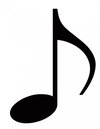Sight Music Theory. Flashcards
The Decks objective is to help students Basic Music Notation and Rhythm.This is a collection of music theory symbols that by the end of the first year music courses you should be able to Identify on sight, like the sight words you learn in kindergarten and first grade.
Name the Accidental and its usage.

The accidental is a flat. It indicates the note that it is placed on should be played a half step lower pitch wise.

Name the Accidental and its usage.

The accidental is a Sharp. It indicates the note that it is placed on should be played a half step higher pitch wise.

Name the Articulation placed on the note below.

This articulation is called an accent. It indicates that one should give emphasis to the front of the note. An accented note should be louder than the notes that surround it.

Name the Articulation placed on the note below.

This is a Staccato articulation. It indicates to place separation from the other notes that surround it (some say that means to play the note shorter than its value).

Name the Accidental and its usage.

The accidental is a natural sign. It indicates the note that it is placed on should be played at its orginal pitch with no alteration.

Name the Articulation placed on the note below.

This is a Heavy Accent. The note is played with a heavy sustained articulation.

Name the Articulation placed on the note below.

This is a tenuto articulation. It indicates to play the note long and sustain with the notes that are surrounding it.

Name the Articulation Listed Below.

This is a Slur. It indicates that the notes should be played connected without articulation when possible.

Indicate the duration of the note below based upon 4/4 time.

Doted halfnote: 3 beats (the dot adds half of the notes value to it).

Indicate the duration of the note below based upon 4/4 time.

Dotted Quarter: one and a half beats long (the dot adds half of the notes value).

Indicate the duration of the note below based upon 4/4 time.

Dotted Eighth:3/4 of a beat (the dot adds half of the notes value to it).

Name the dynamic below and describe it.

Fortissimo: This is a very loud dynamic.

Name the dynamic below and describe it.

Forte: this dynamic indicate to play the music at a loud volume.

Name the dynamic below and describe it.

Mezzo Forte: Indicates to play the music at a medium soft dynamic.

Name the dynamic below and describe it.

piano: It indicates to play the music soft or quiet dynamic.

Name the dynamic below and describe it.

Pianissimo: indicates to play the musical passage very soft.

Identify the clef and the notes on the staff.

This is the Bass Clef or the F clef becaus it circles the F on the staff. The notes on the linesof the staff are GBDFA. A good saying to remember the bass clef lines is Good Boys Do _F_ine _A_lways.

Identify the clef and the notes on the staff.

The Clef is the Treble clef or G-clef because it circles the G line on the staff. The notes are in the spaces of the staf and spell FACE from bottom to the top Space.

Identify the clef and the notes on staff.

The clef is the Bass Clef or the F clef. The notes shown in the spaces of the staff are ACEG from bottom to top of the staff. A good saying to remember the bass clef spaces is All Cars _E_at _G_as.

Identify the clef and the notes on the staff.

This is the Treble Clef or G-clef because it circles the G line of the staff. The treble clef notes on the staff lines bottom to top are EGBDF(see picture). A good saying to remember the treble clef staff lines are Elvis’s Guitar Broke Down Friday.

Identify the note and it’s length in 4/4 time.

Whole Note
In 4/4 time a whole note is 4 beats long.

Identify the note and it’s length in 4/4 time.

Half Note
A half note in 4/4 time receives 2 beats.

Identify the note and it’s length in 4/4 time.

Eighth Note
An eighth note receives 1/2 of a beat in 4/4 time

Identify the note and it’s length in 4/4 time.

Quarter note
A quarter note in 4/4 time is 1 beat in length






























